Streets for People / PeopleforBikes Says Key West Is a “Great” Bicycling City and Ranks It #17 in U.S.A.
For the seventh year in a row, on June 27 PeopleForBikes, the U.S. bicycling industry’s trade association and a national advocacy nonprofit, released its 2023 City Ratings, a comprehensive ranking of cities based on the quality of their bike networks. 1,484 U.S. cities and 249 international places in Canada, Europe, and the U.K were rated. This is the sixth year Key West has been scored and the fourth year we’ve done stories analyzing the Key West data (2022, 2021, 2020).
Key West scored 66 on a 100-point scale earning it 68th place overall and #20 among 946 Small Cities (less than 50,000 population). In 2022 Key West scored 61 and in 2020 scored 58. Of Small Cities, Provincetown, Massachusetts with a score of 88 ranked #1 again for the second year in a row. In 2019, only 35 U.S. cities scored above a 50. In 2022, that number grew to 78 cities. This year, 97 U.S. cities, including Key West were rated as Great Places to Bike with a score above 50. Only 16 U.S. cities, regardless of size, ranked higher than Key West and only 12 U.S. cities made it into the ratings’ Top Fifty overall.
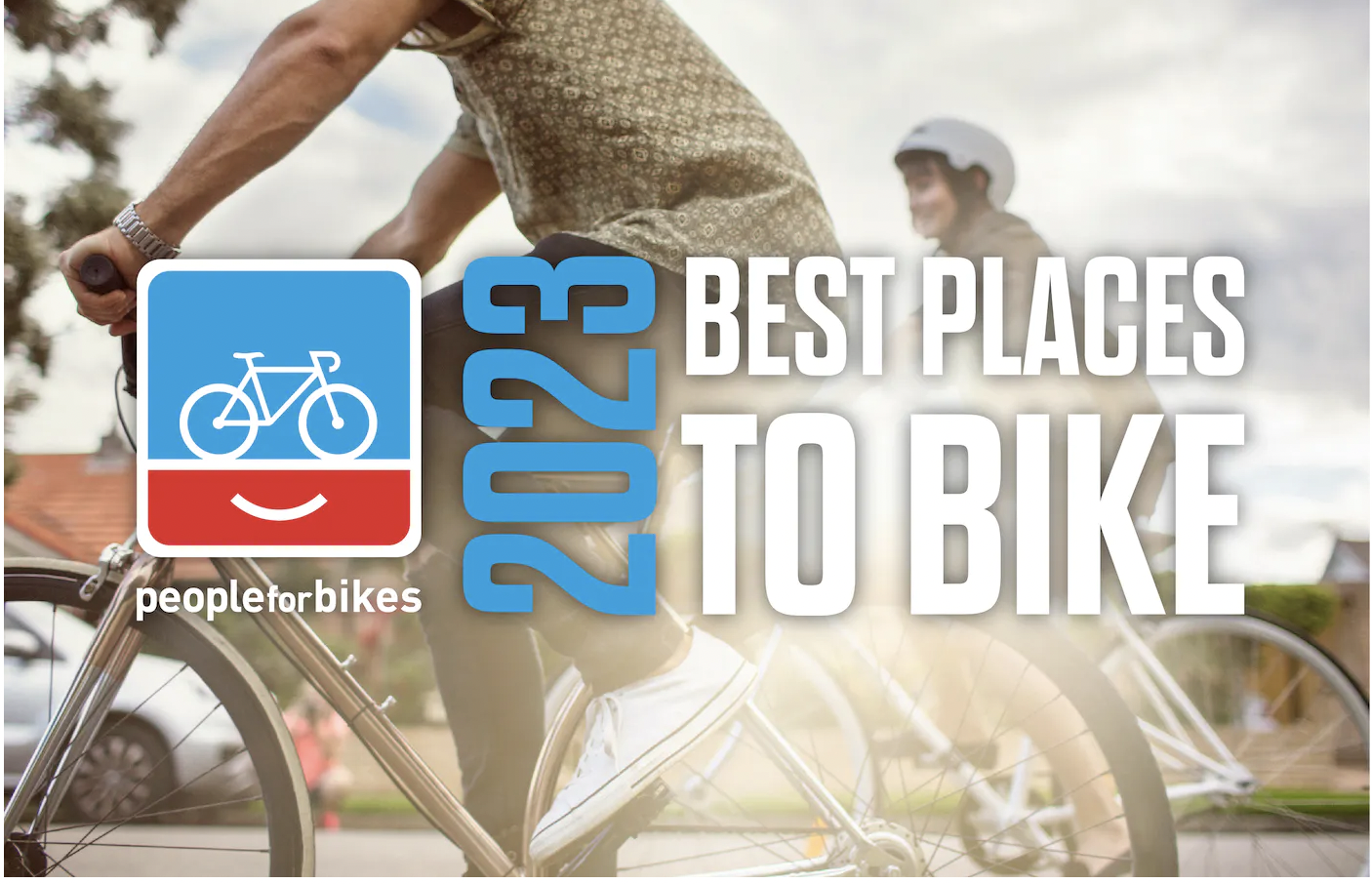
This is good news for our little island paradise. Especially as our score has gone up over each of the last few years. That shows progress. Analysis of the data and discussions with Key West leaders and bicycle advocates reveals that much of our score and excellent ranking has a lot to do with natural factors. We’re compact, flat, and have good weather, so lots of people bike year-round, despite a lack of safe bike facilities in some places – N. Roosevelt Boulevard and Flagler Avenue we’re looking at you. We’ve documented recent progress here, here, here, and here, but in the grand scheme of things these are mostly small investments. We have to ask the question, given our natural advantages, what would Key West’s score and ranking be if we really tried.
If the City can spend $5M annually on public transit operations, what if we spent a similar amount on bicycling every year for a decade? Key West becoming a recognized top bicycle city in North America would enhance our residents’ quality of life, reduce our beleaguered work force’s transportation costs, and could serve as a visitor calling card for an ecotourist demographic that values such things. Let’s dive into the data, hear what some leaders are saying and discuss what this means for bicycling’s future in Key West.
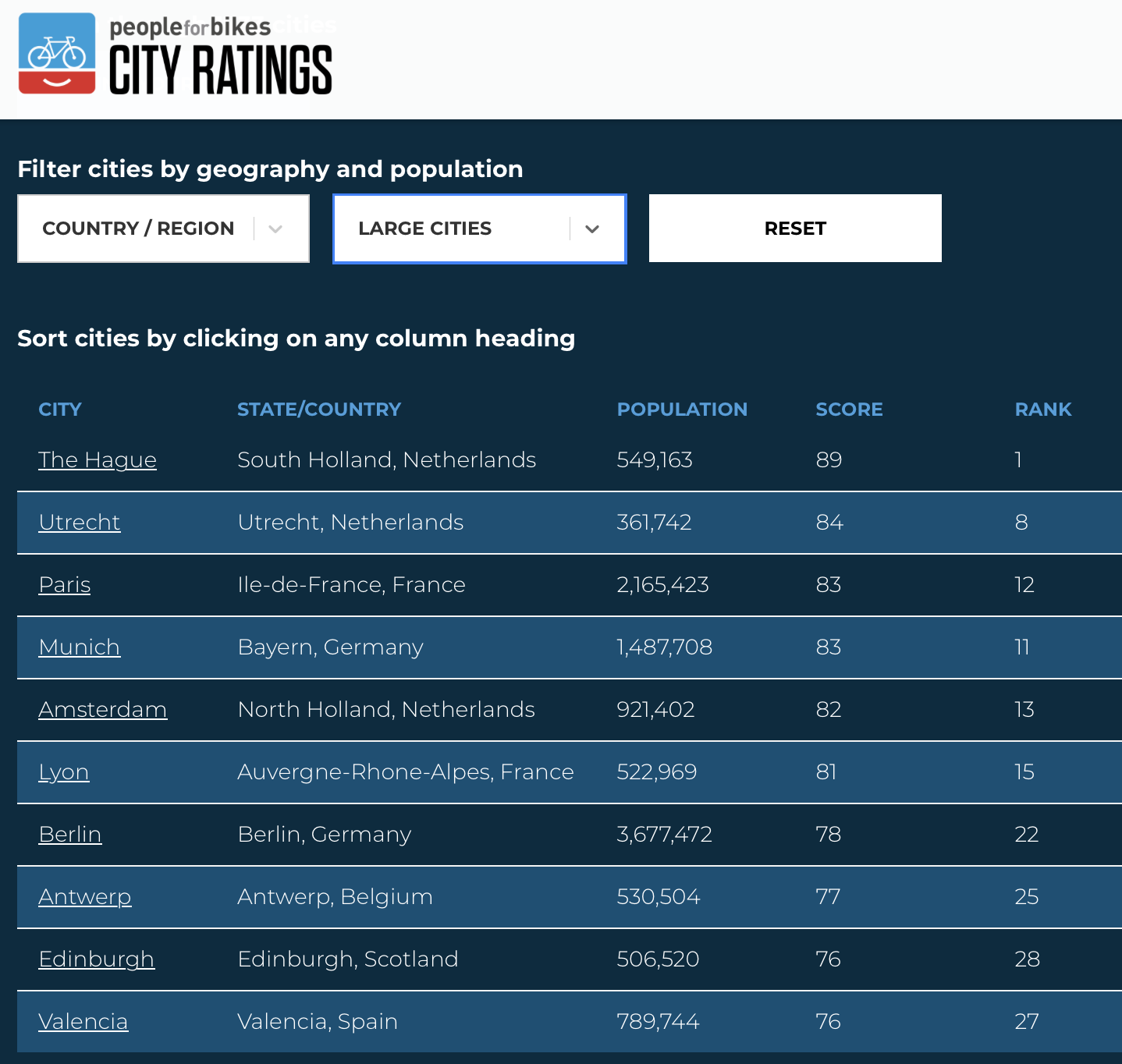
The PeopleForBikes Annual City Ratings = Tough Standards
Each year PeopleForBikes has rated more and more cities, so there’s more competition between places in the rankings. Each city receives a City Ratings score on a scale of 0-100. A low score (0-20) indicates a weak bike network, meaning the city lacks safe bikeways or there are gaps in the network. A high score (80-100) indicates that most common destinations are accessible by safe, comfortable bike routes that serve people of all ages and abilities. Only 18 cities overall scored better than 80. The average score for all cities was 27. Tough standards!
PeopleForBikes says a score of 50 is the tipping point to becoming a great place to bike. But the vast majority of U.S. cities haven’t scored more than 50 points.
“While cities may differ in their paths to becoming great places to bike, the foundation is to build safe, connected, and comfortable bike networks.” said Rebecca Davies, PeopleForBikes’ City Ratings program director. “Every city needs more protected bike lanes, safer intersection crossings, and a modernized approach to street design that works better for everyone, no matter how they choose to travel.”

Bicycle Network Analysis Score
City ratings are based on the Bicycle Network Analysis (BNA) Score, which measures the quality of a city’s bicycle network. A bike network is defined as the system of paths, trails, and streets that someone riding a bike can use to get to everyday destinations. High-scoring cities often perform well across six factors captured in the acronym SPRINT: safe speeds, protected bike lanes, reallocated space for biking and walking, intersection treatments, network connections, and trusted data.
You can read more about SPRINT at How to Improve Your City’s Score. For more granular detail on how the BNA works, read the full methodology. For historical data and details on the software, visit their BNA Mechanics website.

Key West’s BNA Scorecard – Slower Speeds Downtown Fuel Rise In Score
Key West has a BNA Network Score of 66. The essence of the score uses mapping data software to figure out if people can get to places from where they live or “neighborhoods” to jobs, schools, core services, recreation, retail, and transit safely by bike. The safely part is measured by street speeds. If 20 mph or lower that’s good. If the street has higher speeds, does it have protected bike lanes and intersection treatments to get people around to counteract the higher speeds? Are these facilities connected?
As Key West is so compact, it isn’t surprising that people can find a way to get to most places in a safe manner. Here’s this year’s detailed score compared to 2022 and 2021. Access from neighborhoods to jobs, recreation and most things seems good. The only category that isn’t is “Core Services” or places like hospitals and grocery stores. When you realize that both Publix’ and Winn Dixie are on N. Roosevelt and the hospital is on College Road where there are no bike lanes, you understand the low score of 49.
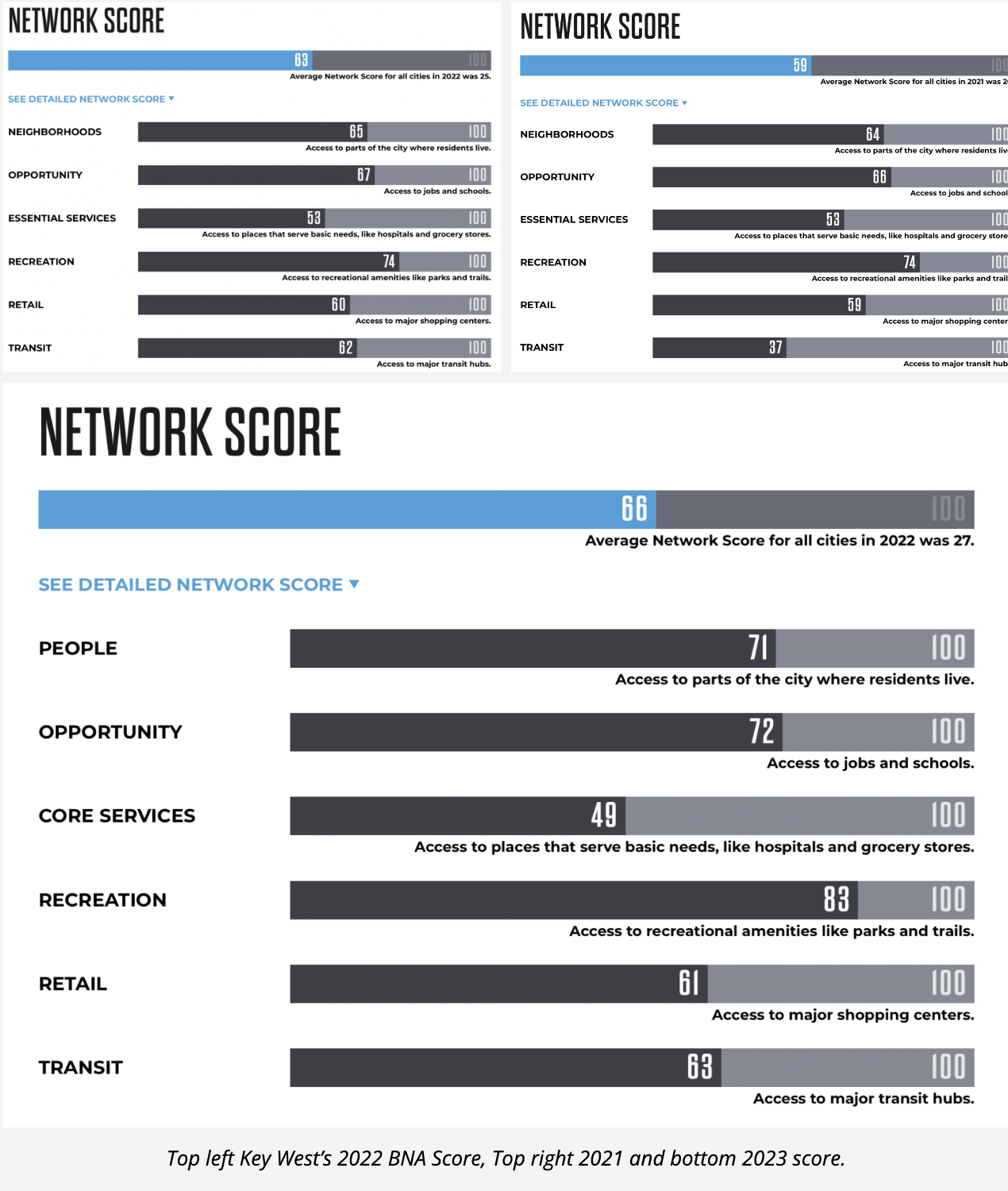
Overall access is visually apparent looking at the BNA Score Stress Map. And it confirms what everyone who lives here already knows. The dangerous streets, those PeopleForBikes depicts in red, are N. Roosevelt Boulevard, Truman Avenue, Flagler Avenue, Palm Avenue, Eaton Street, Kennedy Avenue and College Avenue. Mostly places where the speeds are above 20 mph. Most don’t have bike lanes either.
If we compare the previous year’s Stress Map with this year’s, one can’t help but notice the number of high stress (red) streets downtown has gone down versus last year. As the City hasn’t done a lot of new bike infrastructure in Old Town, we think it might have something to do with the mapping data acknowledging the City’s lowering the speed limit city-wide to 20 mph on most streets. When we talked with the City’s Multi-Modal Coordinator Ryan Stachurski, he verified that yes, he and his team of interns “corrected the speed limits available to the algorithm at OpenStreetMaps” which is the street mapping data that PeopleForBikes uses in the BNA. Ryan added that the City Commission lowered the city-wide speed limits in 2020 on the recommendation of the Parking and Alternative Transportation Group.
So, the improved score, going from 61 to 66, now accurately reflects the slower speeds on the ground downtown and that’s a good thing. It also reflects better, more accurate data, one of the six principles of SPRINT. So good on Ryan and and his team for correcting the data.
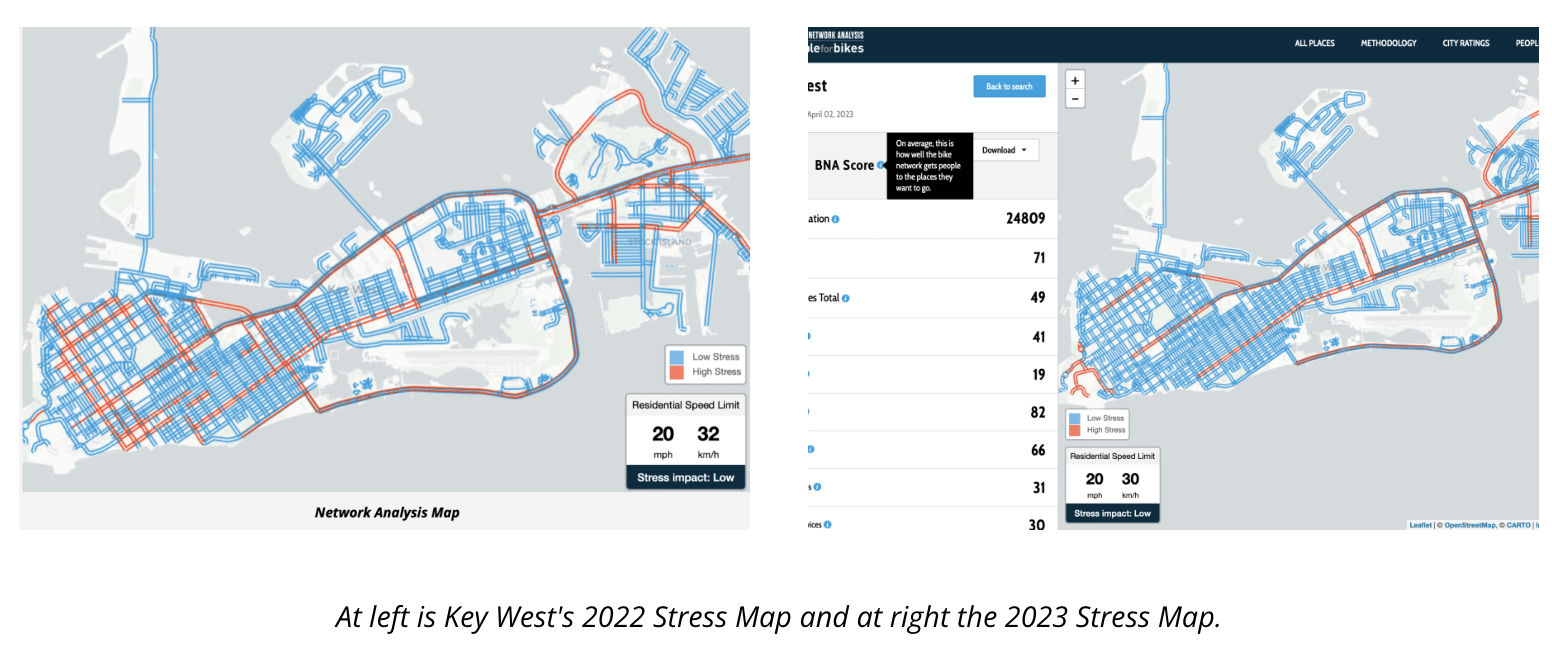
What People Are Saying About Key West’s City Ratings
We asked our Mayor and some bicycle advocates what they thought of Key West’s score and ranking. Opinions were mixed. Here are some of their thoughts:
Key West Mayor Teri Johnston:
“To reduce our congestion, noise, and pollution, we asked our residents and guests to consider an alternate mode of transportation in Key West. They have overwhelmingly supported this “ask” by walking and biking around our incredible island. Now it is our responsibility to provide safe paths for pedestrians and bicyclists by keeping our sidewalks for walkers/joggers and a dedicated bicycle lane for cyclists whether motorized or human powered.”
Tom “The Bike Man” Theisen, Owner, Bike Man Bike Rental Key West:
“I’ve lived here for almost 40 years, bike 10 to 20 miles daily around town and have a bicycle business. I’ve watched the degradation of the Key West cycling experience over the past few years, mostly caused by reckless electric vehicle drivers on our bike paths and additional traffic caused by workers relocating out of Key West.
The city continues to add bike racks and paint lines on the streets to give the appearance of doing something but overall, there have been no significant changes and continued lost opportunities. (Jr. College Rd., First Street and South Roosevelt). The Staples bike bridge is being replaced but I see that as more of a maintenance project rather than an improvement. There is a bike plan, I don’t see any of it being implemented.
There are possibilities to improve biking infrastructure, a path from Salt Ponds to the Government Road, opening additional routes through the cemetery etc. but in most instances removing parking spaces is the only option if Key West wants to improve its bike infrastructure.
The current city commissioners seem to have no interest in improving cycling infrastructure probably because none of them cycle. They represent mostly people who don’t cycle and are more concerned about having cheap, easily accessible parking rather than bike infrastructure. There are a few voting cyclists but generally they don’t vote in Key West because they live on Stock Island, don’t speak English, aren’t citizens, are too young to vote or are here on vacation.
When I hear how well we are doing I shake my head because you could pick any town in the whole, snowy, province of Quebec and they would be kilometers ahead of us as are most U.S. cities when it comes to actually making it safer to bike.”
Roger McVeigh, City of Key West Parks and Recreation Advisory Board:
“The score and rating are very encouraging! This reflects highly on the Mayor, City Commissioners and City Staff, particularly Multimodal Coordinator Ryan Stachurski and Director of Engineering Gary Volenec, for their recent efforts and willingness to move more aggressively forward with change to facilitate safer streets.
That being said, there is so much more that can be done without significant dollars if our leaders are willing to truly invest in public safety and changes in the best interest of all residents and safety, in spite of the predictable outcry of the NIMBYS and the anti-change folks.”
What Do We Need to Do to Improve Key West’s Score and Ranking?
We’ve gotten the low hanging fruit or points out of our natural advantages of being small, flat, great weather and good bones (compact street grid). To significantly improve our score, Key West needs to look to the data, as visualized in the Stress Map, which makes it clear what facilities need to be made safer. Just follow the red streets. One can also look to the recommendations in this article here: Two Bike Crashes This Week Are Two Too Many. Here’s 10 Things to Make Bicycling Safer, November 12, 2022, or look at this quick list:
- Bike lanes on College Road
- Separated paths for bikes on N. Roosevelt and S. Roosevelt
- Building the Wickers Trail segment of the Crosstown Greenway
- Fixing the intersections and driveways on N. Roosevelt
- Making Kennedy Street 2 lanes with a middle turn and protected bike lanes
- Protected bike lanes on the First and Bertha Street Corridor
- Continuing the bike lanes, the length of White Street
- Finishing the Southard Street bike lane into the 300 block
- Installing bike corrals throughout the downtown in the street
- Continuing bike lanes through intersections and installing bike boxes
- Putting a light at Duck Avenue and S. Roosevelt
- Widening the sidewalk on the outbound side of the Triangle
- Educate visitors to slow down and watch out for bikes
- Upgrade the Crosstown Greenway with signage and paint
- Giving bike and e-scooter share a fair shot instead of making it hard to start
- Asking developers to put in less car parking and more bike parking
- Widening sidewalks with parklets
- Build the Salt Ponds and Smathers Beach Bike Trails
- Finish the United and South Street bike lanes
- Connect up all the bike lane and path segments around town
- Reconsider removing parking and installing protected bike lanes throughout downtown including on Whitehead and Simonton
- Make Duval Street more pedestrian and bike friendly
There’s obviously lots of ideas on how to make biking safer and easier. What are we forgetting in this list and article above? As Tom Theisen points out, in order to go beyond simply replacing the facilities we have now and put in new/additional infrastructure like protected bike lanes, separated paths or even just to connect up all the disjointed regular bike lanes, we are going to need to take some car parking out and that’s going to take some political will and spending dollars that we have heretofore not witnessed.
Key West’s Bicycling Future
Key West’s score and ranking in the PeopleForBikes City Ratings are great. But rather than pat ourselves on the back for a job well done, especially when much of that score is because of our natural advantages, we should use this news as a catalyst to spur us on to even higher heights. Imagine Key West being mentioned as one of the greatest bike cities, not just on the continent, but the world. With a little bit of elbow grease and money, it is indeed possible.
Doing this will make life better for our own citizens as we lessen our traffic and downtown parking congestion, clean our air, make ourselves happier and make our Mom-and-Pop shops more prosperous. We can also bring down the cost of living for our beleaguered workforce by allowing more of them to go car-free. When we make it safer and easier to bike we all win!
# # #
Chris Hamilton is founder of the local advocacy group Friends of Car-Free Key West & Duval Street/Historic Downtown. Subscribe to the blog. Follow on Facebook and Twitter. Support ($) our local journalism here. A native of the District of Columbia, where for a couple decades+ he led nationally renowned efforts promoting transit, bike, walk and smart growth for Arlington County, VA’s DOT. Chris has lived in Key West since 2015. He lives car-free downtown and works and volunteers for a few non-profits. You can find three years’ worth of KONK Life Streets for People column articles here and here and the 10 most recent stories below:
- New Staples Avenue Bike/Ped Bridge Coming This Fall, June 23, 2023
- New Garden View Apartments Residents Being Provided Bus and Bike Incentives to Go Car-Free, June 16, 2023
- City Wants Your Help In Locating New Bike Parking, June 2, 2023
- Helping Islanders Go Car-Free Or Car-Lite Can Help With Our Affordable Housing Crisis, May 18, 2023
- Brand New Bike Lanes Coming to United and South Streets, May 5, 2023
- New “Workforce Express” Key West Transit Service Begins May 15 Between Stock Island and Bahama Village, May 3, 2023
- County Officials Reserved On-Street Parking Stands In Way of Completing Southard Street Bike Lane, April 21, 2023
- The Canary In Our Florida Keys Coal Mine Is Our Fragile Water System. Here’s 10 Things to Reign In Overtourism and Overdevelopment that Killed the Bird, March 31, 2023
- New “Locals” Multi-Use Paths Behind the Airport Move Closer to Reality, Maybe, March 17, 2023
- One Year In Lama E-Scooters Are Proving to Be a Success. We Need to Make It Easier for Them to Expand, March 1, 2023

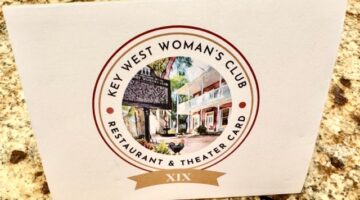



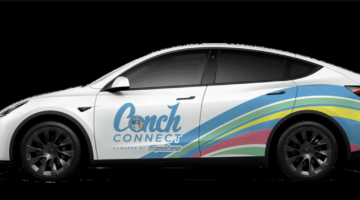
Another excellent bike article. thanks, Chris!